PRODUCT DECONSTRUCTION
RED GLOW Series





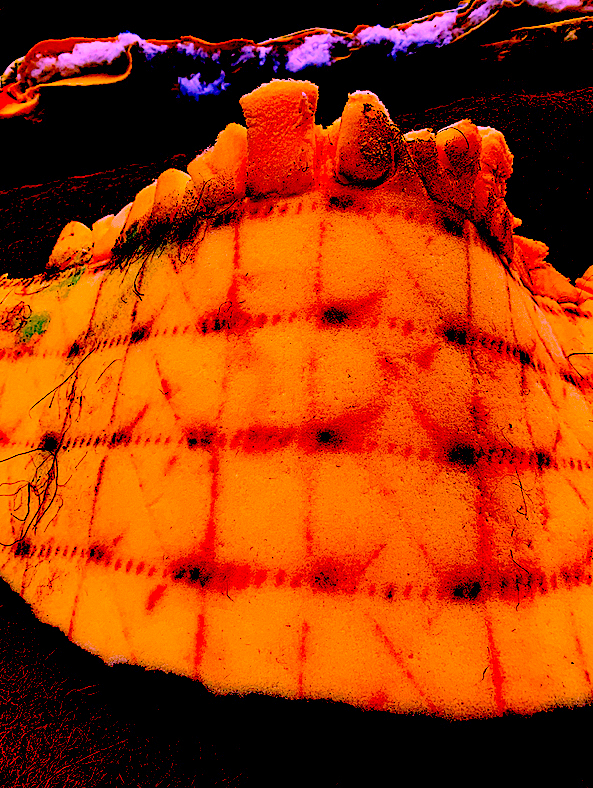





PRODUCT DECONSTRUCTION
RED GLOW Series











PRODUCT DECONSTRUCTION to NEW PRODUCT
‘GOLD HAYSTACK FOLDS’




















‘COLOURED HAYSTACK’


‘HAYSTACK BODIES’









PRODUCT DECONSTRUCTION
BREAKAGE – Deconstruction of a PRODUCT: furniture technology.
Spatial Drawings: This year, I have learnt that drawing is connected to sculpture, but may, or may not involve drawing a 2D or 3D representation of an idea on paper. In the first sculpture brief in Semester 1, I enjoyed shifting a number of large size boxes around within a small space, and it felt quite natural and easy for me. I connected the materials, and made it stand upright by inserting a rod on a diagonal angle. I had created my first spatial sketch or drawing in the air in about 10 to 15 minutes.
This time, I could not create any spatial sketches with my chosen object without destructing the object first.
Before Lockdown occurred a new household item of a bed was purchased. Now, it is not everyday a consumer buys a bed. Therefore, I was very keen to explore the visual possibilities that a piece of technology such as furniture could be investigated, and connected to this Verisimilitude: Real sculpture brief. The old bed had become, just another throwaway piece of rubbish.
Using only scissors and my hands as tools, it took me one day to dismantle the top mattress structure of the bed, and another day to take one of the two berd base parts to pieces. My backyard now contains a rubbish dump pile, an interesting stack of materials (e.g. timber, steel, roller wheels and fabric such as a duvet mattress cotton cover, synthetic foam and hessian type stuffing, etc.) thrown in a heap.
During the deconstruction of the old bed, I focused upon mark-making using just scissors and hands. I ripped and pulled, cutting away large pieces carefully, just in case I needed to reuse these shapes for a sculpture, and when I got tired I ripped freely, and messily. I thought (if time allows) I may be able to use as many different layers of the bed material as possible, either separately or together to create a sculpture or two.
Stopping to photograph each interesting rip and breakage that I made to the mattress, I removed pieces, and rearranged them in heaps, bending and curling some of them. I created interesting assemblages of the material to photograph. Later, on the computer, I digitally removed the original mattress colour of white on each photograph. As I removed the top fabric layer which is padded like a duvet cover, it felt like I was almost taking away the skin, or outer body identity of the mattress. Then, I gave each photograph image of the mattress cover, a new coat of colour (see below).
Through play and movement, and by trialling a generative here-and-now expanded drawing method, I understand how to shift and assemble materials and objects. By mixing materials, new visual possibilities can occur, forming an overall pleasing effect of surfaces, edges and planes touching either the air, ground or each other. It is like dancing with a prop, the object becomes an extension of the body, and both using the space. I am building a relationship between my body’s limbs, my personal space, the place I am in, and the materials that I have chosen to work with.
As this quote reminds me: “The point at which an artwork becomes a sculpture as distinct from a drawing can, in instances, be blurred.”1. There seems to be a fine line between making a spatial sculpture drawing, and a finished sculpture.
Bibliography Drawing : Room. Exhibitions. Accessed September 3, 2021. https://drawingroom.org.uk/exhibitions/drawing-sculpture.









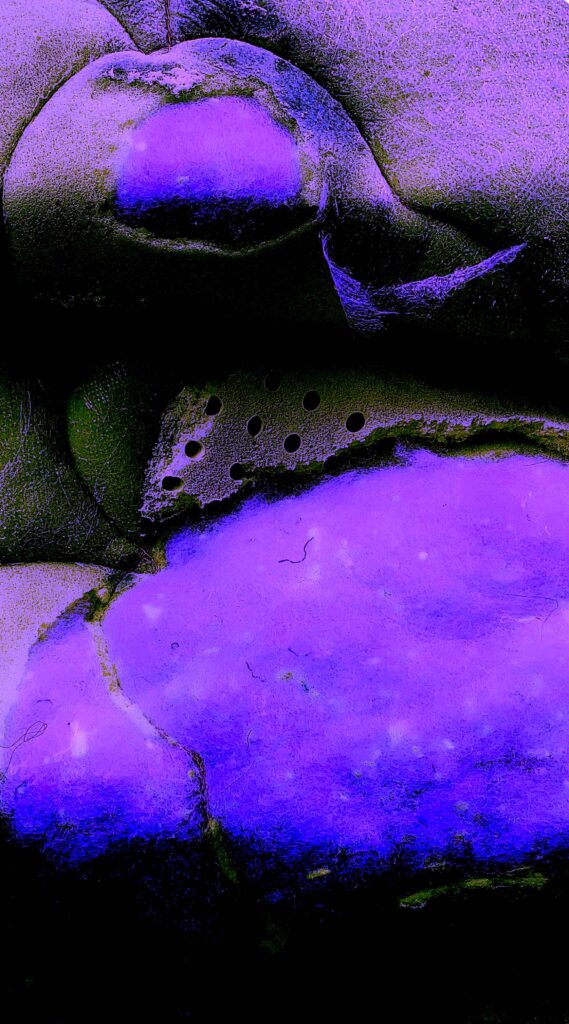


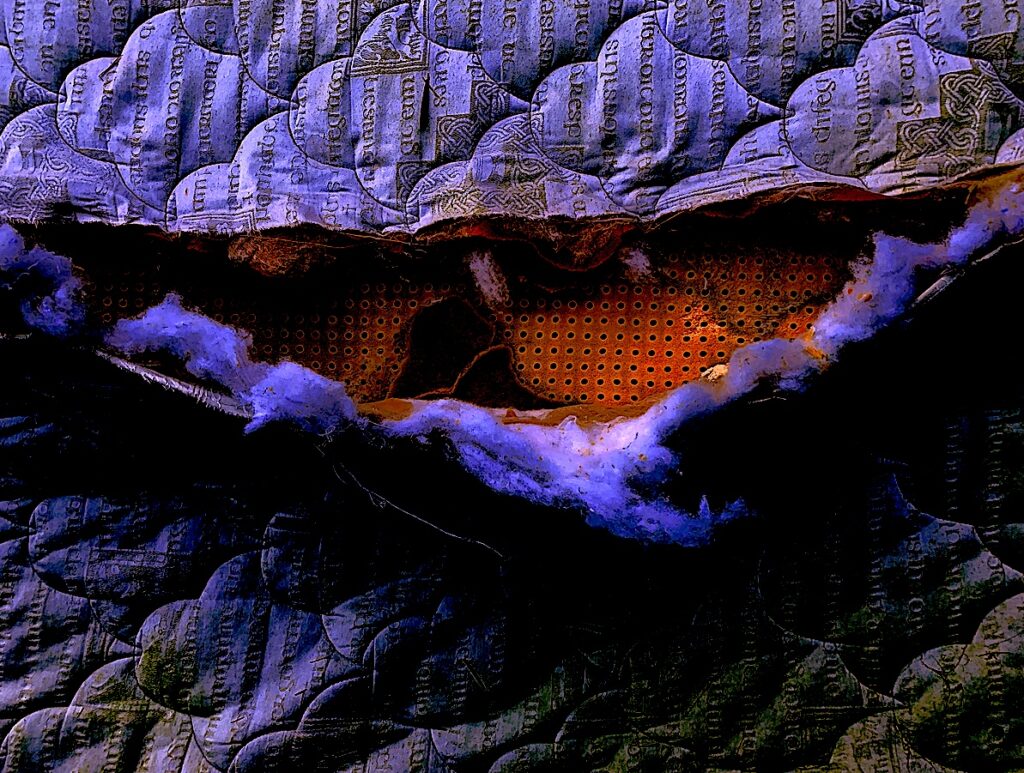

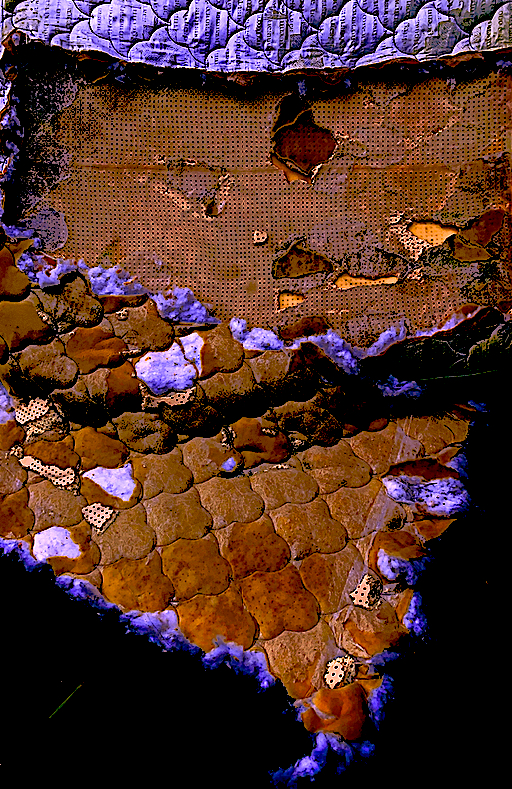








A NEW PRODUCT FOR A BED: ‘Patchwork Quilt‘

Abstract Concept
* VALUE to DESIRE
* DESIRE to CONSUME PRODUCTS or COMMODITIES
* CONSUMPTION of PRODUCTS and COMMODITIES to WASTE
* WASTE PRODUCTS to RECYCLED PRODUCTS or REPRODUCTIONS
“Value leads to desire. Desire leads to more desire, and this cycle of desire leads to an obsession. Consumption leads to more consumption, and this cycle of consumption leads to an obsession. Production leads to more production, and this cycle of production leads to an obsession.” Cathy K.
Value: I value truth, honesty, love, kindness, health, beauty and nature.
I value people, yet humans are only beautiful to me when they are genuine, sincere and truthful, and are not afraid to display real heartfelt emotive qualities like love, empathy, and generosity of spirit. I value peace, not war.
I value Nature, because it is the most beautiful and valuable of all. Human beings desire nature’s products (i.e. water and plants for survival, trees and clay for construction of housing, coal for warmth, gold for wealth and status, oil and diesel for technological transportation and power, etc.), leading to destruction and overconsumption, and unfortunately massive waste. I personally feel awe-inspired by nature, because it is greater than I. Stargazing continuously reminds me how insignificant and small I am. I wonder if every human being understands this notion of valuing Nature, as compared to the overall scheme of things, the human race is not the most important life, because it is not the only life on planet Earth. I value peacefulness, quietness, and time alone in the natural world, such as my garden. I appreciate viewing nature: the whenua (land) and whakatipu tipu (plant life) of Papatūānuku (the earth mother), Tangaroa (the sea) and Ranginui (the sky father). This appreciation of nature is because I value nature’s gift to the body’s senses: seeing, smelling, hearing, touching and tasting its unique beauty and evolutionary characteristics. Like an artwork, I admire nature’s products and performance, its stillness and movement, its expertise and skills, and the harmony and balance of its lines, patterns, shapes, forms and colours.
Human beings exploit planet earth’s resources, and doing so are creating change to our weather patterns and climatic cycles. Therefore, I do value and appreciate how nature is constantly regenerating, reproducing, and recycling its life forms and habitats after millions of years of evolution. Humans have always desired, consumed and wasted products, but world-wide capitalism’s power and politics have driven the consumption of goods, products and commodities to a greater height of desirability in this twenty-first century. Everyone has different experiences, therefore differing tastes, and therefore place different value on certain objects. Yet, the gold element is a high price commodity, therefore most people value it as a prized possession. Humans are taking valuable resources such as precious minerals and metals (i.e. coal, tin, iron, diamonds and gold) from the land, but are not always restoring. Negative human impact on the environment such as mining strips natural resources, leaves the land heavily cut and carved up, and habitats destroyed. Often mining waste debris and runoff pollutes the land and waterways.
I value my health, body and mind. Greed or obsessive desires (i.e. Gold fever, shopaholic or drug addiction) can affect a healthy brain. Humans carry concepts and anxieties in their heads. The brain is a precious taonga, yet many humans do not value the brain. Drugs such as alcohol and, even widely accepted drugs like coffee and tea can change brain dynamics. Are humans placing more value on their own selfish greed to quench their shopaholic thirst by buying the so-called essential items like the latest sports shoes/trainers/sneakers and the purchase of gold items? What do compulsive obsessions do to the brain?
I value education and learning. I value art because it shares (free, or for a price) an encounter in an art gallery, a theatre or through a technological device another voice, narrative and reality. Each artwork is an open book, representing the artist’s personal view and life experience. The artist’s reality (whether it is similar to the viewer’s reality) is a truth, because their artwork is a real object, that they gave thought to, and took time to create. The audience has a choice, or desire, whether to enter into a dialogue, have engagement, or consume the concept.
The audience participant may be able to buy the artwork, thus become a consumer of the product. Caring for, and adoring this prize possession gives this art object meaning and value to the owner. Even if the artwork is not for sale, it may generate an important concept and value that the viewer can freely take away. When an artwork is viewed, we cannot always have that product (whether desired or not). Yet, we can consume the idea, and take the ideas or overall concept away with us. This can lead to a change within your thinking. Perhaps, original reactions and responses to the artwork are not acknowledged fully, but later become consumed through connecting the idea to one’s own set of beliefs or values. Whether the object is consumed and privately prized, or publicly experienced, it is this encounter of the artwork that provides meaning. The overall artwork, or underlying concept can be powerful, or not, but can trigger thought patterns about its reality and its truthfulness. Its provocation can create a greater understanding of one’s own views and values, in relation to other world views and values.
Desire: The notion of desire relates to value. Why does that object have that special meaning? Why do I value that meaning enough to desire it? This concept of desire also links back to my previous spatial sketches displaying the value of gold, and the desire (or not) to have gold related products such as jewellery.
Gold is a transition metal and a group 11 element. It is, and always has been for humans in every society, a desired, valued object (commodity, product or artwork) that when discovered became part of their place, their land, and their culture. Contemporary musicians such as Rap stars wrap gold chains around their bodies to symbolise wealth and status. Gold is a product that humans want. Humans can also express untruthful realities, they may believe that their desires are a definite need, when often they are only wants, not actual needs.
Does the monetary value of an object or artwork mean it is more valuable? Is money, power, consumption and capitalism more important than plant Earth’s nature, which includes human life? Buying and selling is valued, and an economical way of life. Yet, today’s advertising world is extremely powerful, pushing clever marketing ploys to make the consumer desire and wish for something they do not really need. Commodities (natural resources like gold, steel metal, coal, oil and timber to make into products) are important, but will run out eventually, and products (completed goods such as a disused bed that I am recycling into a sculpture) are also significant to consumers.
How does one get that golden fix, that instant gratification, to fill an emptiness or hole? Buy, borrow or steal (especially if it is an obsession such as drugs, gambling or shopping). Shopping online, even in COVID Lockdowns, is today’s instant hit or fix, like drugs or gambling. I personally do not shop for recreation (online, or in shopping malls, etc,). My need to have retail therapy once existed, but I do not value buying products for the sake of buying.
Waste: ‘Out of sight, out of mind’ concept.
How are societies and individual humans dealing with the drive and force of consumerism, and power of capitalism?
How do people step back from that fever of desire (like gold fever) and stop purchasing, stop desiring more things, stop buying for the sake of buying, etc?
How do people become aware of their distorted sense of value, and their deluded mentality of needing a product? Are people being lead down the garden path by consumerism? Do they really believe the latest advertisement promotion: “You need the latest sports or fashion product, you need this gold trinket!”
Are people recognising their needs, compared to their desires and wants? When purchasing products, people need to be more environmentally concerned, and instead of always buying, save money, and walk away from the desire. Fix something old and recycle instead.
How do people dispose of their purchased products safely, and environmentally? Are people getting rid of their rubbish (technology included) appropriately through correct recycling processes?
In our throw-away society, we buy/sell products, and when it is unusable or the desire has disappeared, we have no qualms of throwing the once desired product away. The world has never had such a society as today that produces, consumes and dumps their purchases that were once prized! The well-off individuals and societies have the ability to buy, sell and throw away by dumping. Tossing away their consumption is automatic, and without care or thought. Not only our precious oceans, but the surface of our land, and beneath the surface are becoming massive dumping yards. Plastic is dropped, and blown over land, and sits in bundles in warehouses waiting for humans to recycle or dispose of them, and floats or sinks in our oceans. Physically burying rubbish under the ground in rubbish dumps can lead to runoff such as chemical leakage into the soil and eventually the waterways. Rubbish and dump sites are been filled up in record numbers. What will happen when humans fill up the land with their own waste products?
ARTMAKING: Abstract Notion of Deconstruction and Construction.
Deconstruction: I find breaking and cutting (deconstructing) objects, or ideas interesting and fun. My product (once a valued Bed mattress and base) is now waste, junk material placed in my backyard ready to be destructed, or disposed of as rubbish.
If one cuts, or breaks apart or destroys an object on purpose, such as an old broken machine, one can find value in the object. Sometimes there is an appreciation for it, more than when it was mechanically working. The true reality (and spirit) of the actual work, and the effort of the maker or producer becomes clear and evident. As I destructed the bed technology (a piece of useful furniture) I took my time. I stopped, and noticed interesting and complicated mechanical parts like the foam fabric, the fine web-like netting and exposed metal: spring steel coils. I began to understand the actual, real workings of the bed, and I valued the usefulness of the product, and the time I had spent resting and sleeping in it. As I broke the bed, it gave me its real meaning, and thus value.
Construction: The deconstruction part was physically hard, but perhaps an easier process than my next step of remaking. The visualisation of seeing ahead to an overall big picture is quite easy for me, (whether my ideas are good, or not). The difficult part is actually the reconstruction of new sculptural works. As I cut myself on the steel metal during the deconstructing process, I questioned are all the bed materials safe (physically harmful, or hazardous) to recycle? Which parts do I use to remake a product? How can I actually produce an item? How can I create a new sculpture from an undesirable piece of furniture? Once my bed product was a desired item, but is now old and in need of retirement. How can I recreate and reproduce this rubbish (disused bed) into an object of desire? Or will it become just another waste product, and end up beneath our earth mother… Papatūānuku? Cathy K.
Artist Model: Chiharu Shiota (b. 1955 Japan).
Chiharu Shiota works in Berlin, Germany. She has created many large-scale sculptural installations comprised of criss-cross intertwining threads such as “Uncertain Journey” and “Where are We Going?”.



Mid-year semester break in July gave me an opportunity to visit Shiota’s latest installation: “The Web of Time” (2020), exhibiting now at Te Papa Tongarewa, Museum of New Zealand, Wellington. Walking through, and seeing her intricate weaving work was inspiring. It was a beautiful spider web wonderland, an escapism that enveloped me as the participant viewer. Beneath infinite falling number constellations, I was swimming in starlit space, where time proceeds earth. I curved through the fishing net sea, seeing silverly numbers, caught and trapped like fish, as if the number of years, thus time had stopped still. Being right next to the entrance of The Museum Boijmans Van Beuningen’s Surrealist Art exhibition, it correlated perfectly, both literally, metaphorically and physically. It was a beautiful and marvellous encounter, a new kind of reality, removing me from myself, a tasty surrealist entrée, proceeding the Surrealist feast.


Chiharu Shiota started creating installations and sculptures after she felt her career as a graphic artist could not fully express her thinking. Her works focus on her feelings of anxiety and pain, and battles with cancer.
I relate to Chiharu Shiota’s work, as we both like colours and numbers, well… as a teacher I enjoyed teaching mathematical geometry, measurement, statistics, algebra and number. I fully understand her statement: “I wanted to create a three-dimensional drawing, so I started working with yarn. With the thread I can draw in the air in an unlimited space.”[1] When I was a dancer, I needed to respond to the space by drawing in the air with my body extensions. Bending, flowing, high and low, my torso and limbs would constantly circulate within my personal space, and create relationships by moving beyond into another dancer’s personal space to connect and move as one. I also relate to, and can empathise with her personal struggles.
During the 1960s and 1970s, Venezuelan Gertrud Louise Goldschmidt (b1912 – d1994) known as Gego, was an influential modernist artist. She created geometric and kinetic sculptures, describing her drawing in space as “drawings without paper”. Chiharu Shiota’s work displays connections to her work, and to Gego’s web-like installation below.


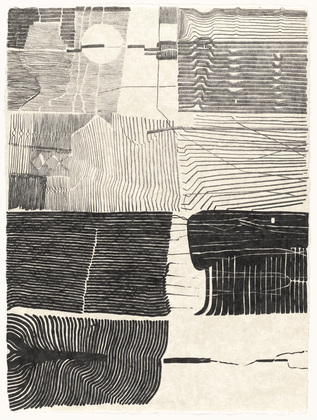





In an art historical context, I have made a web-link between four artists, and their working art field/style of Surrealism, Minimalism. and their genre mediums of sculpture and installations, plus their subject matter of containment and web structures. In my Theory work, I have made a connection between André Breton and his “Manifesto of Surrealism – Soluble Fish” (1924), and the subject matter (web) link to Marcel Duchamp’s “Mile of String”, (1942), and to Chiharu Shiota’s “The Web of Time” (2020), and now to Gego’s “Reticulárea” (1969). All web-like installation exhibits are inspiring and striking dream-like realities for me, as they focus upon containment within a space, or appear as an enclosed theatrical backdrop. As a youngster, I performed as a dancing spider, climbing up a massive vertical web contained within a stage set (backdrop, wings and front curtain). Living for years in the rectangular prism volume of a theatre stage space was like living in a containment of dreams, it was the happiest time of my existence. Thank you Shiota, Gego and Duchamp for resurfacing some happy web-like memories.
Bibliography
Meruk, Anat. Open Ed Tech. ״Where Are We Going?״ Chiharu Shiota / Le Bon Marché.” Accessed August 30, 2021. https://medium.com/open-edtech/where-are-we-going-chiaru-shiota-le-bon-march%C3%A9-14a2e52e528a.
Tate Americas Foundation, courtesy of the Latin American Acquisitions Committee 2019. “Reticularea.” (1969). Gego (Gertrud Goldschmidt) 1912-1994. Accessed 30, 2021. http://www.tate.org.uk/art/work/T15285.
Note: [1] Tonga, Nina. Museum of New Zealand Te Papa Tongarewa. “Because of Covid-19, numbers have become even more powerful”: An interview with Chiharu Shiota. Accessed August 30, 2021. https://www.tepapa.govt.nz/visit/exhibitions/toi-art/chiharu-shiota-web-time.
WikiArt, Visual Art Encyclopedia. “Gego.” Gego Gertrude Goldschmidt. August 1, 1912; Hamburg, Germany September 17, 1994. German, Venezuela. Op Art, Minimalism. sculpture. Field: printmaking, sculpture, design, drawing, installation. en.wikipedia.org/wiki/Gego Accessed August 30, 2021. https://www.wikiart.org/en/gego.
Wittrock, Annika. Ignant.com. Chiharu Shiota. “Uncertain Journeys”. Accessed August 30, 2021. https://www.ignant.com/2016/09/27/chiharu-shiota-uncertain-journey/.
Artist Model: Erwin Wurm (b Austria, 1955).
Erwin Wurm is a contemporary sculptural and photographic conceptual artist. I am drawn to his inspirational sense of humour, and his ability to draw, sculpt, and photograph instructional, choreographed, thus organised performance and video work.


Wurm is known for his one-minute sculptural drawings, performance sculptures and photographs. His dust sculptures of the 1980s to 1990s were inventive. An empty space and an imprint of residual dust was left after coating dust to an object, and then removing it.
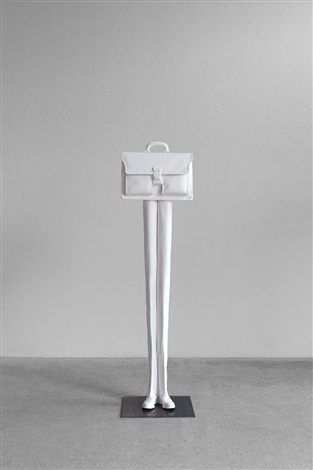

Wurm’s performative sculptures (using either himself, or actors and models) involve an immediacy, therefore just like ephemeral dance, he documents and maintains his sculptural works through the medium of photography. His work is playful and ironical using odd props, and just like comical dance choreography that uses props, he features the human body and makes bodily connections to a range of everyday objects. Some people may think his sculptures are absurd, yet I believe they are theatrical, and connected to daily life. Many of his actor/model-sculpture body positions act out every day happenings, or activities such as pulling on clothes, bending down and multi-tasking by picking up many objects, or just resting by leaning against objects, etc.


A stage performance dancer or actor wears a weighted down mass of costume (head to toe), and often holds a prop. Instead, Wurm’s performance sculptures wear everyday contemporary clothes, making them feel accessible to the viewer. My awareness of my human body’s form, weight and gravitational movement in a contained volume and confined stage space is highly attuned. Controlling my ability to start, stop and hold a position in stillness like a sculpture, and transfer the weight by movement into another sculpted position was a required skill as a dance performance artist. Occasionally, the costume or headdress could cause an imbalance and hinderance. Wurm shows balance and imbalance and, the precarious nature of objects tilting and tipping.


Erwin Wurm acknowledges that the human body is a sculpture, not dissimilar to historical classical sculptural monuments. Traditional three-dimensional solid material sculptures of human bodies and their objects sit on plinths and mark an event, or a person of status. Whereas, Wurm advocates that his human performative sculptures also hold aloft objects and occupy a space, just like sculptural tradition.

Are Erwin Wurm’s photographic works and sculptures real and truthful? Wurm’s self-portraits and sculpture models are functioning human beings who breathe life into their interpretations as living performance artists. They are of course real. They occupy a space, are placed in set positions, hold objects, and are in the present moment, as any artist performer needs to be in front of an audience. Erwin Wurm preserves their function, their represented truthfulness, thus their reality through the medium of photography.
Bibliography
ArtBasel. Cristina Guerra Contemporary Art. ‘Gulp with Pullover’ Sculpture. acrylic, wool. 49.0 x 43.0 x 50.0 (cm). Accessed August 29, 2021. https://www.artbasel.com/catalog/artwork/43435/Erwin-Wurm-Gulp-with-Pullover.
Artnet. Erwin Wurm. ‘Director (Herrentasche).’ Accessed August 29, 2021. http://www.artnet.com/artists/erwin-wurm/.
Kolesnikov-Jessop, Sonia. ‘Erwin Wurm, Hypnosis.’ 2008. Courtesy of Rudolf Budja Gallery and the artist. Accessed August 29, 2021. https://www.cobosocial.com/dossiers/erwin-wurm-our-one-minute-man/.
O’ Regan, Kathryn. Sleek. Photography. ‘Artist Erwin Wurm on taking the seriousness out of sculpture.’ 30 January, 2020. Accessed August 29, 2021. https://www.sleek-mag.com/article/erwin-wurm-sculpture-absurd-new-york-exhibition/.
Pogrebin, Robin. The New york Times. ‘Erwin Wurm Brings ‘One Minute Sculptures’ to Lehmann Maupin’. March 22, 2017. Accessed August 29, 2021. https://www.nytimes.com/2017/03/22/arts/design/erwin-wurm-brings-one-minute-sculptures-to-lehmann-maupin.html.
Public Delivery. Erwin Wurm’s One Minute Sculptures are refreshing
July 21, 2021. Accessed August 29, 2021. https://publicdelivery.org/erwin-wurm-one-minute-sculptures/.
Artist Model: Robert Smithson (b 1938 – d 1973, USA).
Robert Smithson started his career by drawing, collaging and painting whilst living in New York. After visiting abandoned industrial and quarry land sites he began sculpture, producing geometric and minimalist works. After venturing through the West and Southwest desert lands of America, he became interested in the desert land space as a possibility for shaping art in the landscape.
Interested in the natural physical landscape and how humans intervened, Smithson used repetition and enlargement in his work: The Photo-Markers. After photographing the site, he then rephotographed his enlarged photograph by placing it back into the same site, thus mark-making by doubling in a repetitive manner.

For his sculpture in The Sites / Nonsites series, Smithson purposely intervened by disturbing and removing surface land elements such as sand, soil and rocks, transporting them back to a gallery space, and reframing them as art objects. He was taking the outside inside, and using the medium of photography to capture the time effects of duration, decay and deterioration that would continue to create change to his sculptural objects.

Smithson is known for his massive large-scale earthworks. Just like a mining or a construction company, whether it was ethical or environmentally sound, Smithson reformed the land by shifting, adding and removing both the surface and core earth structure of the natural environment. An international large-scale project in the Netherlands was built in 1971, and titled: Broken Circle/Spiral Hill.

American Art Historian Rosalind Krauss in her essay ‘Sculpture in the Expanded Field’, October 8, (1979) 31-44, states that during 1968 and 1970, artists such as Robert Smithson were beginning to occupy the complex area of her expanded-field-axis theory. His sculpture titled: Partially Buried Woodshed, Ohio, 1970, not only makes connections to the complex axis of landscape and architecture, but becomes both landscape and architecture, or a new postmodernist sculpture term called “site construction”.


Spiral Jetty, Great Salt Lake, Utah, 1970, is a significant sculptural and constructional feat, leaving the land and entering the water. Six thousand, six hundred and fifty tons of crushed rock were built into an enormous pier-like spiral structure, which occasionally submerges underwater. Krauss also states how Smithson’s Spiral Jetty could also reflect landscape and non-landscape, thus connecting to another side of her expanded-field-axis.
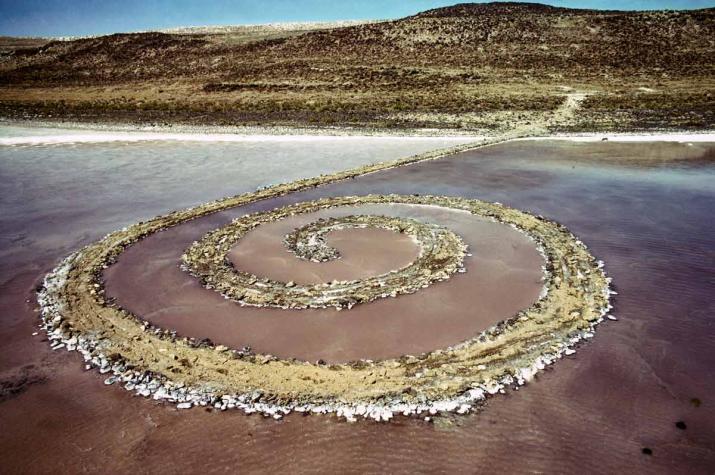
Spiral Jetty. Site specific artwork. Gary Shapiro. November, 2019ISBN 978-1-952603-02-0
Throughout his artistic photographic practice, Smithson’s body was part of the art-making process, for he had the ability to measure and map the land, pour and dig the soil, and use mirrors and writing to theorise and reflect upon his sculptural earthworks. Therefore, his art is clearly truthful and real. Smithson was not only a photographer, writer and sculptor, he was also working in the fields of landscaping and architecture.

Bibliography
Holt/Smithson Foundation. New York. Robert Smithson, “A Nonsite (Franklin, New Jersey)” (1968). Phyllis Tuchman. May, 2020ISBN 978-1-952603-05-1. Accessed August 28, 2021. https://holtsmithsonfoundation.org/writings-on-smithson.
Holt/Smithson Foundation. New York. “Writings on Robert Smithson.” Accessed August 28, 2021. https://holtsmithsonfoundation.org/writings-on-smithson.
Holt/Smithson Foundation. New York. “Asphalt Rundown.” Robert Smithson. Accessed August 28, 2021. https://holtsmithsonfoundation.org/asphalt-rundown.
Krauss, Rosalind. “Sculpture in the Expanded Field.” October 8, (1979): 41. Accessed August 28, 2021. http://doi.org/10.2307/778224.
Mundy, Jennifer. Tate Gallery. “The Gallery of Lost Art: Robert Smithson”. ‘Partially Buried Shed.” Accessed August 28, 2021. https://www.tate.org.uk/art/artists/robert-smithson-4541/lost-art-robert-smithson.
Nowness. Director Crump, James. “Land art masterpieces such as Robert Smithson’s “Spiral Jetty” and Michael Heizer’s “Double Negative.” YouTube. Accessed August 28, 2021. https://www.youtube.com/watch?v=FVRgwEQX3zs.
LOCKDOWN – Semester 2, August, 2021
List of Art and Craft Tools and Supplies available to me.
| Art Room: (South, West facing spare room with two large windows and good light). |
| Table |
| Easel |
| Art Sketchbook / Drawing diary |
| Pencils, Coloured Pencils |
| Vivid Markers and Felt-tip Pens, Biro Pens |
| Stapler, Staples, |
| Staple-gun, Glue-gun |
| Containers / Jars |
| Sellotape, Masking tape |
| Sewing Machine |
| Cotton Thread |
| Buttons, Ribbons |
| Scraps of Fabric |
| Canvas Scraps |
| Old Canvas |
| Scissors |
| Paper (White/Black/Coloured) |
| Cardboard |
| Paint |
| Paintbrushes |
| Clay / Plasticine Oil-based Clay / Paper-clay |
| Clay tools |
| Wire |
| Magazines |
| Bamboo and Metal garden stakes |
| Junk: Timber / Wooden Pallets / Old Mattress, Rusty Metal coil wire / Copper Pipe / Broken Terracotta pot |
| Machinery – Power Tools: Jigsaw / Drill / Sander / Electric Saw, etc. |
| Hand-tools: Hammer / Nails / Screws / Screwdriver / Saw / Pair of Pliers / Clamps, etc. |
Spatial Sketch 6. Cast Acrylic Perspex Sculpture
(Ideas: Treasure Box / Bullion / Coin / Abstract Figure)
My Spatial Sketch 6 will also have a focus on the changing states of GOLD and BUTTER using MELTING. Yet, this time, my material will be a Cast Acrylic Sheet of Perspex, coloured golden yellow to represent GOLD. Again, the focus will be to heat and cool the Perspex over an established shape or form, such as a GOLD BULLION form or a GOLD treasure chest for GOLD coins. I may need to create a timber mould, or reuse objects around the house such as my (oblong and hemisphere-shaped) ice trays.
Another BODY sculpture idea that interests me involves creating an abstract head and shoulder bust. I could trial using the Cast Acrylic Perspex which also further extends my clay figure portrait head. I have many ideas that include cutting, drilling, and gluing, plus thermoforming and bending via heat. The transparent clarity and surface hardness could make a good sculptural form. I may not be able to bend it sufficiently for my above ideas such as a treasure box or abstract figure, but I would be interested in experimenting with this material.
Spatial Sketch 5. Family Photograph Connection: GOLD Bullions & GOLD Nuggets in a Bottle.
I was very fortunate as a child, as my father enjoyed taking our family on adventure holiday excursions throughout Aotearoa . One South Island West Coast tourist destination that was inspirational as a child, and now relates to my GOLD concept is: ‘Shantytown’ (a recreated 19th century pioneer town based on the 1860’s Gold Rushes). Yet, instead of focusing upon MELTING, my sculptural GOLD concept will be focused upon WEIGHT.
This is personally interesting to me, as my father’s Geologist occupation and interest in natural science was influential and inspiring to me. As a family, we were lucky enough to experience holding GOLD bullions (see photographs below of my older siblings and father), and they were definitely heavy to hold as a young child.
My childhood Family photographs have triggered many ideas such as PERFORMANCE Art (rein-acting GOLD panning) as my photograph below shows. Or, I could increase the size and scale of a sculpture by modelling in clay an oversize bullion, or building a replica of my REAL bottle of GOLD nuggets, but on a larger scale.
I enjoy collecting objects, therefore another sculpture idea could include arranging ‘Found Objects’ (spray painted GOLD) into a hand-made bottle shape made out of Acrylic Perspex.








